In 2016, the world understood that there is great potential in investing in Bitcoin (BTC). This is why many people have not traded it since then. After the annual halving, it is highly likely for Bitcoin price to surge. Apart from this, not a small number of people are actively trading. In any case, you need to have a secure digital wallet to keep your assets in.
While hardware wallets are not the only solution, they undeniably provide the highest level of security. Remember the FTX case and how many people could have avoided falling prey to fraud if they kept their assets in a hardware wallet.
The best way to go about this depends on the usage. However, for maximum security, keeping your digital wallet on a cold storage device is always recommended. Instead of a thumbstick, we now have several hardware wallets that allow just that. They come with custom firmware and offer different security features.
Here we will quickly go through 5 of the best hardware wallets to store your cryptos.
Best Hardware Wallets in 2023: Top 5 Hardware Wallets to Store Your Cryptos
1. Trezor (any model)

Trezor stands as one of the leading hardware wallet options and surely desires the #1 place in our top hardware wallets article, offering an exceptional storage solution for safeguarding your valuable cryptocurrencies.
With its primary objective being the protection of your private keys and minimizing online exposure, Trezor achieves this by utilizing the device itself along with a user-friendly web-based app as the wallet interface.
Trezor follows a traditional approach to its setup and functionalities as a prominent player in the hardware wallet market. It encompasses essential features such as standard key pair initialization, recovery seed generation, a two-interface transaction signing system, and the added security measure of a PIN-Passphrase combination.
In terms of hardware, Trezor relies on the STM32 microcontroller, which is open to community-based audits.
What truly sets Trezor apart is its utilization of open-source software, which fosters community-driven contributions and enhances transparency. This unique aspect encourages collaboration and enables users to verify the integrity of the software they are using, instilling a greater sense of trust.
How to Use Trezor Wallet (any model)
You can use the Trezor Wallet to secure your transactions (receive and send cryptocurrency), manage multiple accounts, access cryptocurrency wallets, and other features.
But before that, the first thing you’ll have to do with Trezor Wallet is set up your account. Setting up your Trezor Wallet is a straightforward process that takes approximately 10-15 minutes and includes the steps which you can see in the video above.
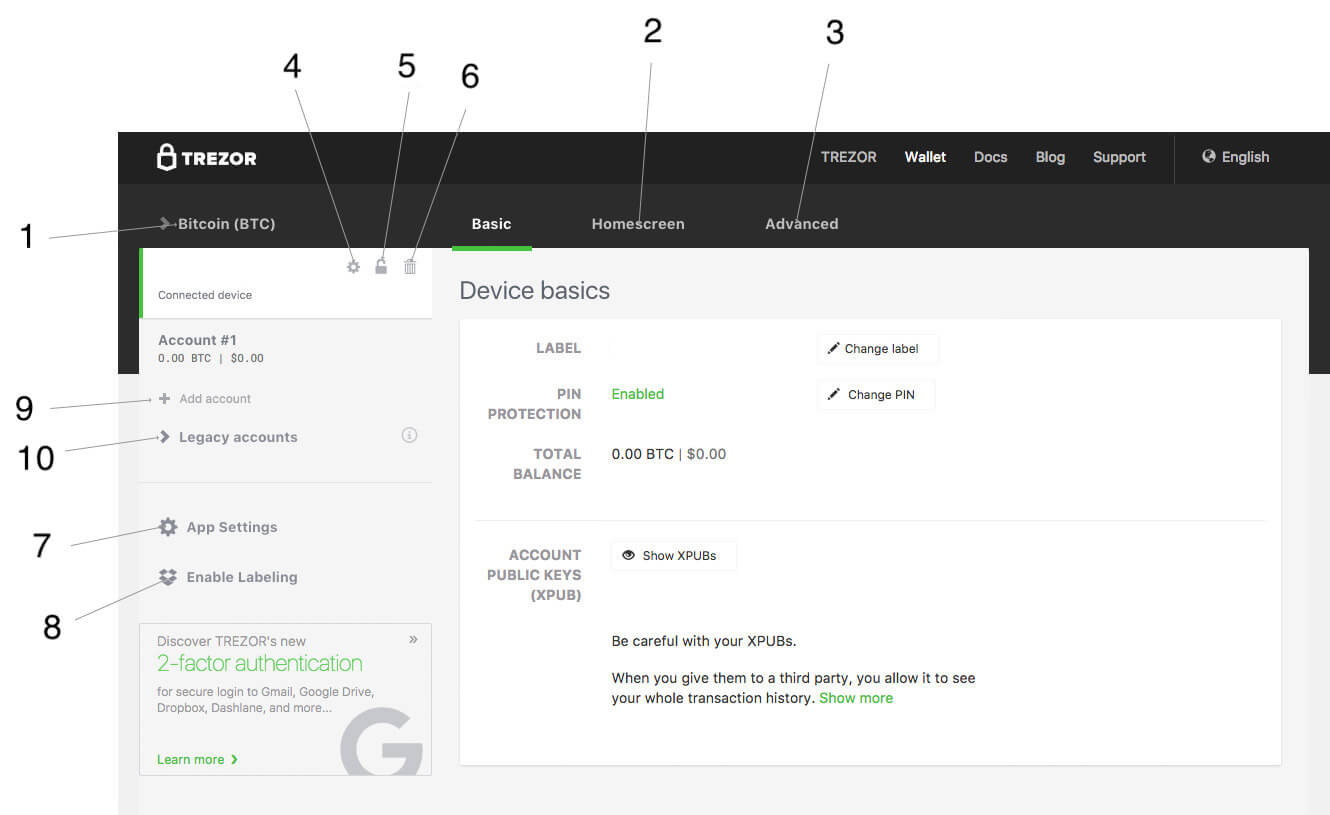
Below is some information on how to use your wallet, including what the many features of the wallet web extension do:
- Access your cryptocurrency wallet.
- Customize your device’s homescreen according to your preferences.
- Manage security features – Enable or turn off the passphrase and PIN for added protection. If needed, you can also wipe (remove all information) from your TREZOR device.
- Edit the basic settings of your device, such as changing the label and PIN.
- Lock your TREZOR device when not in use to ensure its security.
- Forget your TREZOR device from your connected accounts if necessary.
- Modify fiat currency, currency backend, and bitcore server URL settings to align with your preferences.
- Connect your TREZOR device to Dropbox to access additional features like renaming accounts and labelling receiving addresses.
- Add new accounts to your TREZOR device.
- Include old accounts before the implementation of SegWit (Segregated Witness).
Pros of Trezor Wallet
- Trezor is an open-source wallet that benefits from firmware and software contributions from the community, ensuring continuous development and greater transparency;
- With its straightforward and efficient design, Trezor incorporates a built-in security module that utilizes a single microcontroller, providing robust protection for your digital assets;
- Trezor supports a wide range of cryptocurrencies, allowing you to manage a diverse portfolio securely.
Cons of Trezor Wallet
- Does not include a built-in app or Bluetooth support, focusing on a more offline and secure approach to wallet functionality;
- While Trezor offers a range of features, it does not actively support staking functionalities, limiting its capability to participate in specific blockchain networks’ consensus mechanisms;
- Trezor does not provide direct management of non-fungible tokens (NFTs).
Coins Supported on Trezor Wallet
Trezor Suite provides native support for over 40 cryptocurrencies on the Trezor Model T and over 12 cryptocurrencies on the Trezor Model One. Additionally, it is compatible with all ERC-20 tokens. Trezor hardware wallets can be used for other cryptocurrencies but must be managed through third-party wallet interfaces such as MetaMask.
2. SafePal S1

Our second choice is SafePal S1. SafePal S1 is a hardware wallet that prioritizes security and anonymity, providing a reliable solution for storing and managing digital assets.
Developed with support from Binance, SafePal offers a user-friendly interface and a range of features tailored to crypto enthusiasts.
To manage SafePal products, users can rely on the SafePal app, which is a centralized hub for storing and conducting crypto transactions. The wallet simplifies the process by generating a pool of keys upon activation, and users are advised to record the recovery seed for added security. Transactions are performed offline using QR code scanning, minimizing the risk of online threats. Additionally, SafePal incorporates the PIN-passphrase combination to enhance protection.
With a focus on security, SafePal boasts a long-lasting battery and does not rely on USB, WiFi, or Bluetooth connectivity. The wallet reduces the risk of remote attacks and unauthorized access by eliminating the need for wireless connections.
How to Use SafePal Wallet
The SafePal Wallet lets you securely conduct transactions (send, receive, swap), manage multiple accounts, access different cryptocurrency wallets, and enjoy additional features like anti-malware or self-destruct features. To begin using the SafePal Wallet, the first step is to set up your account. You can follow the steps in the video above for a detailed walkthrough.
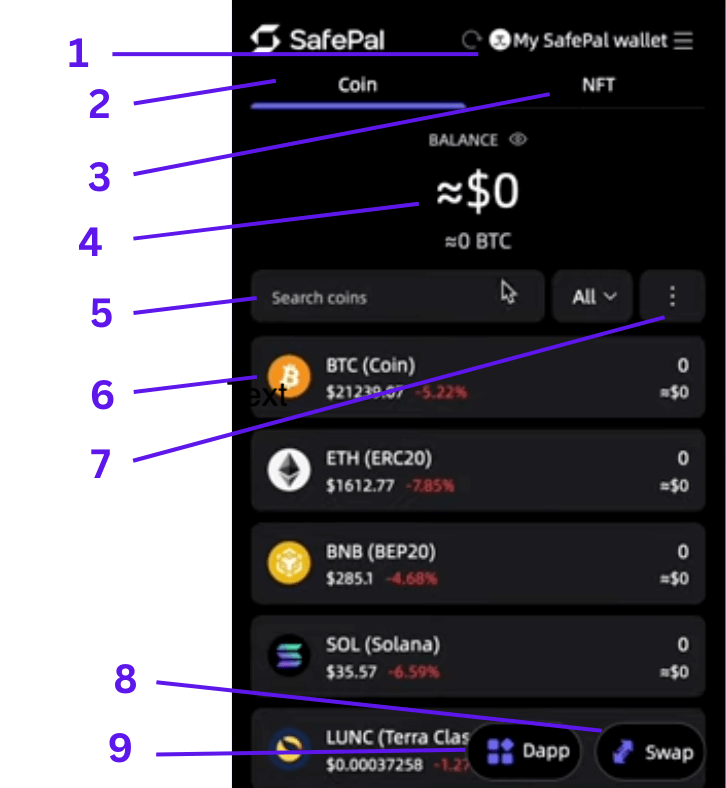
After completing the set-up process, you must download the SafePal app and connect it to your wallet by scanning QR codes using your phone and wallet. After that, the interface will open, which you can also see in the image above. We used the SafePal Chrome Extension, similar to the app interface, so the steps are the same on both. So, below is some relevant information on how to use SafePal Wallet:
- Easily manage your wallets, including switching between them, locking, destroying, changing names, and accessing wallet settings;
- Explore the wide range of available cryptocurrencies;
- Discover and browse through the collection of your available NFTs.
- Check your wallet balance;
- Search for a specific cryptocurrency/NFT;
- Access a comprehensive interface to view detailed information about a specific cryptocurrency. You can send, receive, swap, and review your transaction history from there;
- Access an additional page with more advanced customization settings;
- Make a direct swap within your wallet;
- Connect your wallet to various DApps for expanded functionality and interaction.
Pros of SafePal S1 Wallet
- It’s an affordable wallet solution;
- Includes an anti-malware self-destruct feature;
- Provides multi-layer security measures;
- Ensures compatibility with other leading hardware wallets.
Cons of SafePal S1 Wallet
- It relies on QR codes for usage, which may be slightly cumbersome for some users;
- Features a basic plastic construction;
- Not an open-source wallet.
Coins Supported on SafePal S1 Wallet
SafePal wallet supports 54+ blockchain networks and offers unlimited currency storage, including Bitcoin, Ethereum, Shiba Inu, and other crypto coins and tokens.
3. NGRAVE ZERO
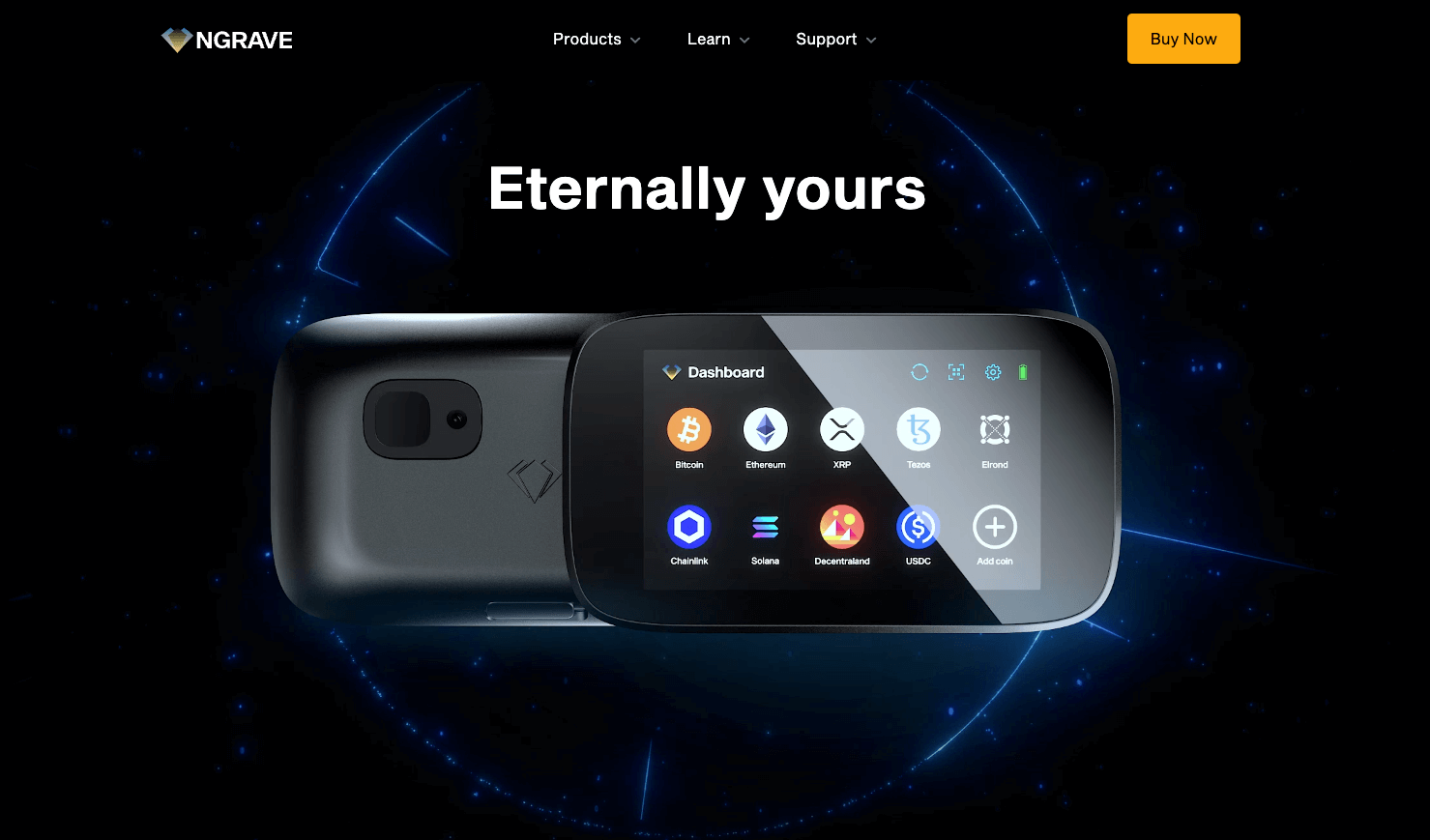
NGRAVE has significantly impacted the industry as a newcomer, offering innovative hardware wallets prioritizing security. Their flagship product, the NGRAVE ZERO, stands out as the “coldest” wallet ever created, ensuring robust protection by completely disconnecting from the internet and potential vulnerabilities. Instead, it relies on a QR-code approach and a dedicated offline transaction processing mobile app.
As a popular alternative to other wallets, NGRAVE brings notable advantages. The device’s design reflects military-grade durability and reliability, while the NGRAVE ZERO is the first wallet to obtain the prestigious EAL7 certification, highlighting its commitment to top-tier security. It incorporates the ARM TrustZone, a built-in integrity verifier that constantly scans for potential threats.
NGRAVE introduces the cutting-edge technology of NGRAVE Perfect Key, which generates private keys securely, adding an extra layer of protection. Additionally, NGRAVE wallets can function independently without physical connections or internet access. The wallet’s app only connects to the internet when users broadcast transactions to the blockchain, minimizing exposure.
How to Use NGRAVE ZERO
The NGRAVE Wallet provides a secure way to transact, manage multiple accounts, access various cryptocurrency wallets, and benefit from other features. To get started with NGRAVE, you need to set up your account. Watch the video above for a step-by-step guide on how to do this.
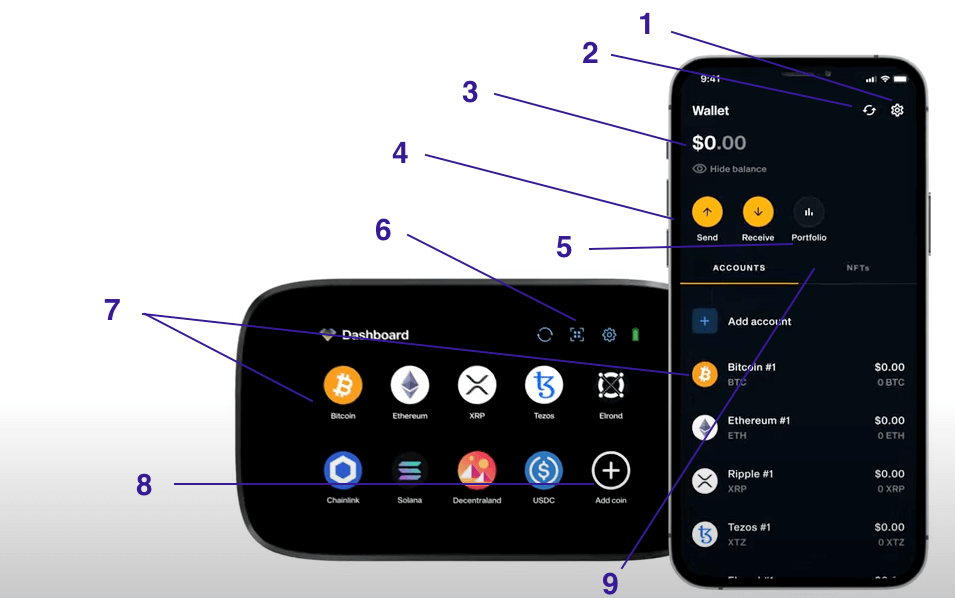
After setting up your account, you need to download the Liquid Wallet app and sync your NGRAVE ZERO with the app. Of course, you will have to scan QR codes.
After these issues, in the NGRAVE ZERO interface or Liquid app, you can do the following:
- Customize NGRAVE Liquid or cold wallet application settings;
- Synchronize your ZERO with the Liquid app;
- View your wallet balance;
- Send or receive cryptocurrency securely;
- Access your wallet for managing your digital assets;
- Scan the QR code to log into the mobile app;
- Explore the menu of a specific cryptocurrency to manage transactions (send or receive);
- Add a new cryptocurrency not natively supported by NGRAVE;
- Browse the NFTs page to view and manage your NFT collection.
Pros of NGRAVE ZERO
- Enhanced security through air-gapping technology;
- Touchscreen interface with an appealing design and practical functionality;
- Software rated EAL7 for increased assurance;
- Resistant to tampering, dust, and water damage.
Cons of NGRAVE ZERO
- Positioned in the premium price range;
- Requires the NGRAVE Liquid mobile app for conducting blockchain transactions.
Coins Supported on NGRAVE ZERO
NGRAVE natively supports 16 cryptocurrencies, including Bitcoin, Ethereum, MultiversX, and others, and is compatible with all tokens in the Ethereum network (ERC-20 tokens) and MultiversX network (ESDT tokens). In addition, all NFTs in the Ethereum network are supported to be stored.
4. Ledger (any model)
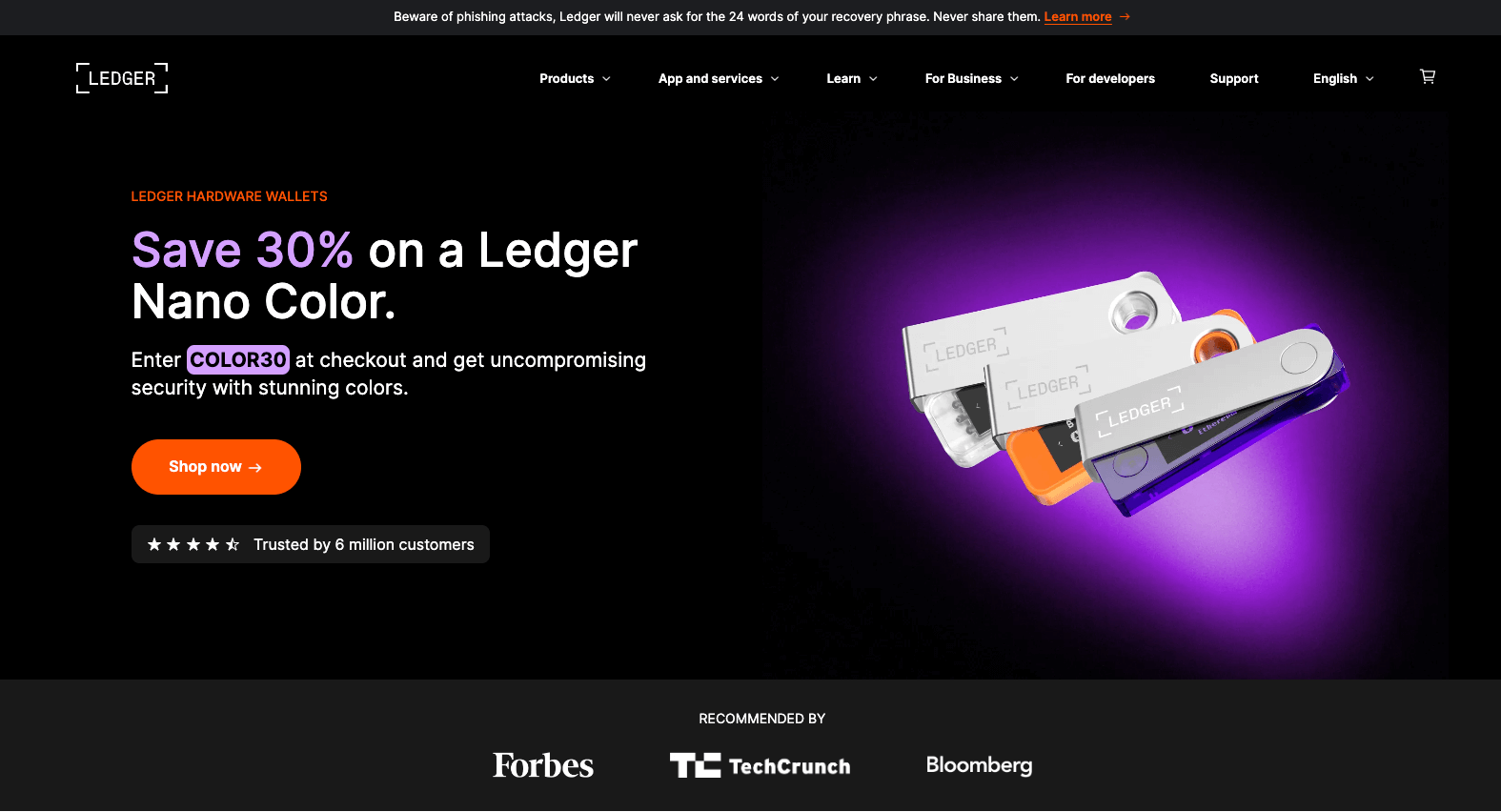
Ledger’s products have dropped down our top because of the controversies that arose in April and May 2023 related to that firmware update, previous breaches, and their “stylish” necklace idea. However, it still remains one of the best hardware wallets on the market.
Ledger Wallets are secure and user-friendly, designed for storing and managing cryptocurrencies. With a presence in both Paris and San Francisco, Ledger strives to provide robust solutions for blockchain applications led by a team of experts in embedded security and cryptocurrencies.
These hardware wallets act as personal vaults, protecting cryptocurrencies from online threats like hackers and malware. What sets Ledger Wallet apart is its innovative and intuitive design, catering to users of all levels of expertise. You don’t need a tech expert to manage your digital assets securely because it’s accessible to everyone.
The company employs advanced encryption techniques to protect users’ sensitive information.
How to Use Ledger Wallet (any model)
Ledger Wallet can be used for many things, including buying, selling, sending, storing, staking, managing cryptocurrencies or NFTs, and other things like discovering new opportunities.
As required by the other featured wallets (and probably all the hardware ones out there), you must first go through a setup process. You can watch the video above to see how to set it up.
Of course, it is also necessary to download the Ledger Live app.
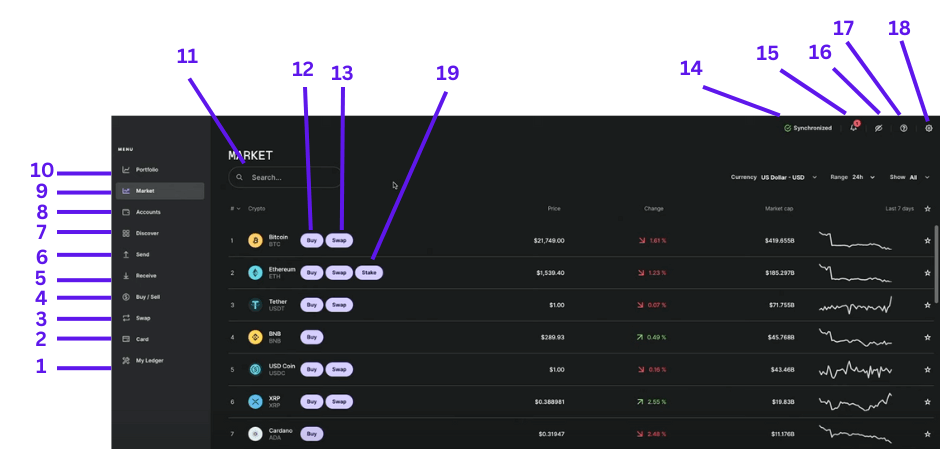
Whether you use the Ledger Live website or the mobile app, you will have access to the following features that you can use:
- Explore device details: check storage space, installed cryptocurrencies, and more;
- Add cards for coin purchases;
- Navigate to the swap section for easy cryptocurrency exchanges;
- Buy or sell cryptocurrencies within the platform;
- Access the receive section for crypto and NFT transactions;
- Send cryptocurrencies or NFTs securely;
- Stay updated with the latest crypto news on the dedicated page;
- Manage your Ledger accounts and create new ones;
- Get insights on available cryptocurrencies supported by Ledger;
- Monitor your crypto portfolio;
- Search for different cryptocurrencies quickly;
- Instantly buy specific crypto assets with a shortcut;
- Swiftly swap between different cryptocurrencies;
- Verify synchronization with the Ledger Live mobile app;
- Check notifications for important updates;
- Enable discreet mode to hide your balance value;
- Access the comprehensive FAQs section for support;
- Customize settings like language, theme, region, and others;
- Engage in staking for that respective cryptocurrency (you can also do this from the “Portfolio” section).
Pros of Ledger Wallet
- Native staking and NFT management capabilities;
- Highly secure wallet with advanced security features;
- Mobile app with convenient Bluetooth connection;
- Extensive crypto education library for users.
Cons of Ledger Wallet
- Software is not fully open source;
- Higher entry price compared to some alternatives;
- The recent controversy surrounding Ledger’s security and privacy concerns.
Coins Supported on Ledger Wallet
Ledger supports natively over 50 cryptocurrencies, all ERC-20 tokens, and some BEF-20 tokens.
5. KeepKey
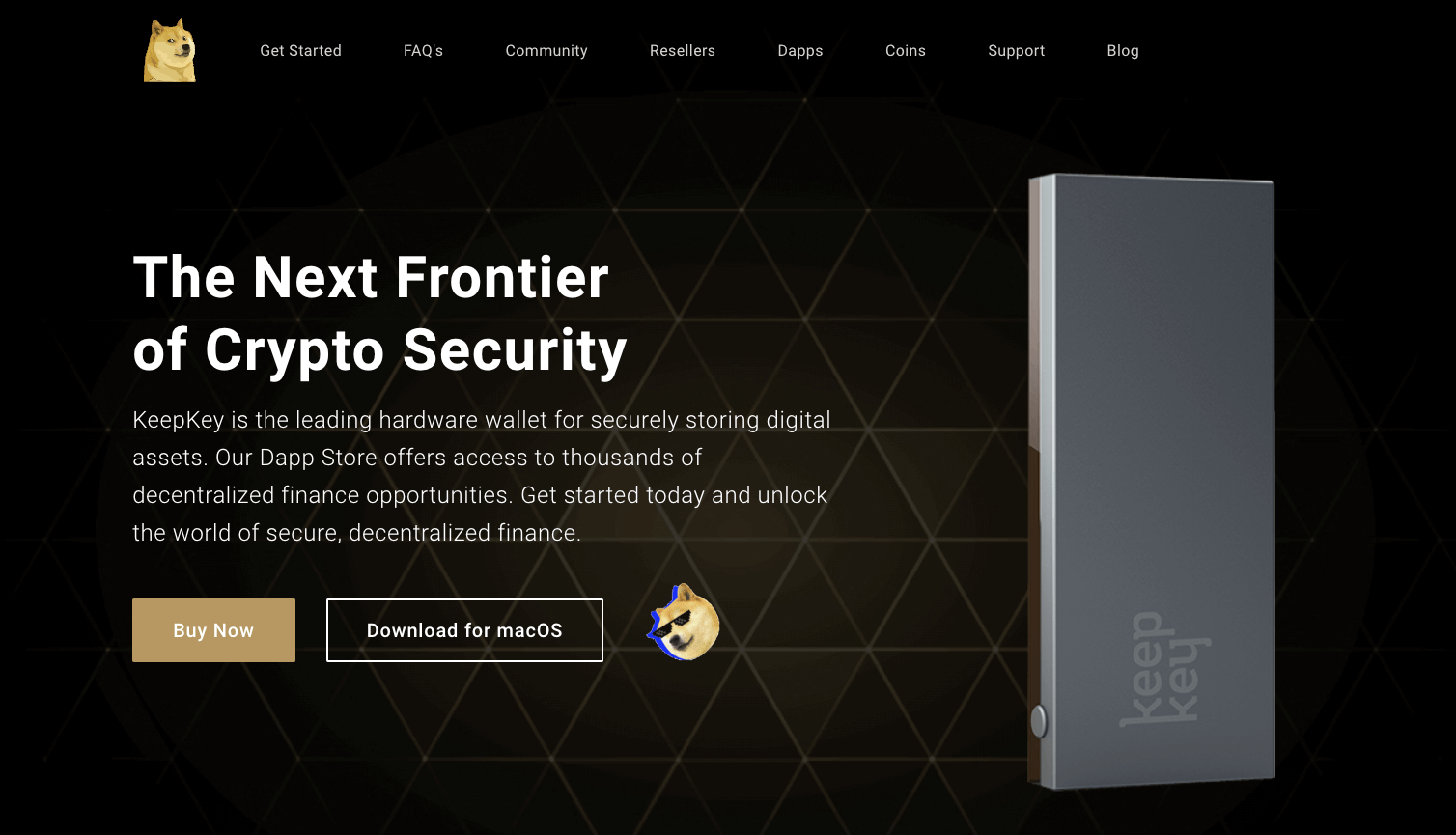
Last but not least, KeepKey is our #5 and standout choice. Developed by ShapeShift, a reputable crypto-to-crypto exchange, KeepKey offers advanced features and comprehensive security for your digital assets.
KeepKey ensures security by handling key generation, storage, and transaction verification. It keeps your cryptocurrencies offline and protected on the device while maintaining seamless communication with your computer through its secure interface.
KeepKey is integrated with ShapeShift, enabling direct asset trading and purchasing within the device. This integration enhances user experience by providing a streamlined and convenient way to manage your assets.
With its large display, KeepKey offers enhanced visibility and ease of use compared to other hardware wallets. The device is fortified against viruses, malware, and hacker attacks, ensuring the security of your funds. It incorporates multiple layers of protection, including PIN security, a 12-word mnemonic recovery phrase, and tamper-proof firmware.
How to Use KeepKey
KeepKey allows you to send, receive, and manage your crypto assets, as well as access other features like the possibility to buy crypto from your wallet based on the integration with ShapeShift.
As you can see in the video above, the KeepKey setup also requires the KeepKey client, which can be downloaded from their website.

Once your wallet is updated and you go through the setup process, you will be able to use the following sections:
- Manage your KeepKey account and customize its settings;
- View a concise summary of your account on the wallet dashboard;
- Manage your cryptocurrency addresses and add new ones within the wallet;
- Access your wallet and manage your digital assets securely;
- Manage your payment cards for purchasing crypto assets;
- Explore and manage the available assets on your KeepKey wallet;
- Access the DeFi section for decentralized finance options;
- Enter the trade section to execute crypto trades;
- Access the ShapeShift exchange directly from your KeepKey wallet;
- Utilize the search option to find specific features or assets;
- Stay updated with notifications related to your KeepKey wallet;
- Connect your KeepKey wallet to decentralized applications (DApps);
- Check the balance of your accounts within the wallet.
Pros of KeepKey
- Straightforward user interface with a sleek OLED display for easy navigation and interaction;
- Wide range of supported cryptocurrencies;
- Robust security measures to safeguard funds and private information, providing peace of mind;
- Attractive pricing for the value it offers.
Cons of KeepKey
- No Bluetooth support;
- Lack of support for NFTs;
- Additional software requirement. Unlike some wallets, KeepKey does not have a web wallet feature, needing the download and installation of other software like Electrum or MultiBit;
- Limited portability. KeepKey’s larger size makes it less portable compared to more compact alternatives like Trezor.
Supported Coins on KeepKey
The KeepKey hardware wallet offers support for a wide range of top cryptocurrencies (over 50), including popular coins like Solana, Cardano, and Dogecoin, as well as all ERC-20 tokens.
FAQ
What is a Hardware Wallet?
Hardware wallets are physical devices, similar to USB sticks, that store cryptocurrencies offline for enhanced security. They act as isolated computers, allowing users to sign transactions with their private keys within the device. These signed transactions are then securely transferred to the blockchain using a crypto bridge. While they may be less convenient than mobile or “hot wallets,” they provide superior protection against online threats.
Which Hardware Wallets are the Safest?
The safest hardware wallets are Trezor (any model), SafePal S1, NGRAVE ZERO, Ledger (any model), and KeepKey. Of course, these are the most reliable based on our research, so we invite you to do your own research based on our article and other reputable industry publications.
How Do I Choose a Crypto Hardware Wallet?
In order to choose a crypto hardware wallet, you must consider the following factors:
- Security – Opt for wallets with robust features like two-factor authentication, encryption, and multi-signature support. Research the wallet’s security track record and any past incidents of hacking.
- User-Friendliness – Select a wallet that is easy to use and has an intuitive interface. Ensure it supports the cryptocurrencies you want to store and offers a simple backup and recovery process.
- Reputation – Check the reputation of the wallet provider by reading reviews and feedback from other users. Look into the company’s history, including management and notable events.
- Compatibility – Verify if the wallet is compatible with your device and operating system, whether iOS or Android.
- Fees – Consider wallets that charge reasonable fees for transactions and account maintenance. Be cautious of highly low-fee wallets, which might compromise security or reliability.
Which Hardware Wallet Supports the Most Coins?
Our research shows that Trezor and Ledger support the most coins and tokens.
What are the Risks of a Hardware Wallet?
Despite their reputation for security, hardware wallets are not immune to vulnerabilities. These devices have shown potential weaknesses that attackers can exploit, potentially jeopardizing investors’ funds. Even the most advanced hardware wallets can be compromised through various methods by determined hackers.
Conclusion
In crypto, the significance of safeguarding your funds cannot be overstated. When it comes to security, compromise is not an option. That’s where hardware wallets come to the rescue as guardians of your digital wealth.
These remarkable devices offer more than just a means of storage. They symbolize peace of mind, knowing that your hard-earned assets are shielded from the ever-present threats lurking. With hardware wallets, your cryptocurrency finds solace in offline or “cold” storage, isolated from the vast reaches of the internet. The tangible nature of these physical devices instills a sense of reassurance as they assume the role of resilient fortresses for your financial autonomy.
So, in this article about the best 5 best hardware wallets, you’ll find one you can trust that will make you embrace the peace of mind that comes with total control over your digital assets within the confines of a hardware wallet.


